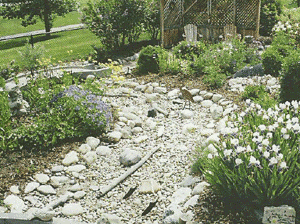A Waterless Water Feature
A dry streambed can add the look and feel of a water feature but contain no water at all. In some cases, a rock creek bed can be a seasonal water handling method where run off during a torrential rainstorm can use the stream bed to be directed away from a building.

Use a dry stream bed to capture water that otherwise would make its own way off the property and divert it to somewhere useful such as a pond or bog garden.
The Japanese style of building a dry stream bed is to use rocks to line a trench which can be planted with moss or filled with gravel, screened and graded to size or left natural.
It depends on the look and the style you want – defined and clean, or more rustic and rural.
Emulating a mountain brook with tumbling rocks and water worn stones gives a completely different feeling than a simple channel to divert water dripping from a roof.
The more simple a design is, the more challenging it will be to carry it off successfully. The trick is to make it random, using different sizes of rocks, placed in the way that nature would do it.

Disguising the liner, if one is used, with carefully laid rocks, can be a challenge. Use larger rocks to form steps that can be filled with smaller stones, gravel and sand to imitate the look of a naturally formed stream.
Driftwood and water rounded boulders also contribute to the idea of a natural water course.
A Japanese style bridge is a great focal point, or simple stepping stones or one large rock spanning the dry streambed just emphasizes the concept of water, whether it’s actually present or not.
Plantings around the dry stone creek bed can consist of only one or two species of plants, even just moss to soften the boulders, or can be a mixture of plants.

Choose those native to your area or drought tolerant plants that can survive with little to no extra moisture.
When the dry streambed is built on a slope or hillside, care in the design to make it blend in at the beginning and end of its journey is crucial – make it look real, and fool your visitors – in a really nice way, of course.
If you’re in an area that only gets a few rainfalls each year, but every one is a major storm, you’ll need a different set up than a place that has steady but short rain fall events.
Using a dry stream bed in conjunction with ponds, bog gardens or rain gardens as water storage systems is a great way to combine functions, and add beauty to your xeric garden.

